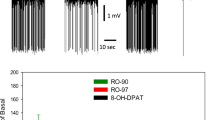Abstract
Rationale. In animal models of reduced dopamine transmission, such as haloperidol-induced catalepsy or monoamine-depleted animals, serotonin (5-hydroxytryptamine; 5-HT) 5-HT1A agonists appear to enhance motor activity. However, the exact mechanism remains unclear.
Objective. The objective of the present study was to demonstrate that 5-HT1A agonists can increase locomotor activity by activation of postsynaptic 5-HT1A heteroreceptors without the involvement of somatodendritic 5-HT1A autoreceptors which are known to regulate 5-HT neuronal activity.
Methods. The effects of the 5-HT1A full agonist R-(+)-8-hydroxy-2-(di-n-propylamino)tertralin (R-(+)-8-OHDPAT) on locomotor activity in reserpinized (i.e., monoamine-depleted) rats were studied.
Results. The present data demonstrate that R-(+)-8-OHDPAT significantly increased locomotor activity in monoamine-depleted animals at a dose as low as 0.01 mg/kg. The partial 5-HT1A agonist/D2 antagonist buspirone (3 mg/kg) also elevated locomotor activity. The effects of these 5-HT1A compounds were found to be similar to the locomotor-stimulating effect of the dopamine precursor 3,4-dihydroxyphenylalanine (150 mg/kg, 15 min after 50 mg/kg benserazide). The 5-HT1A antagonist N-[2-[4-(2-methoxyphenyl)-1-piperazinyl]ethyl]-N-2-pyridinyl-cyclohexanecarboxamide maleate (WAY 100635; 0.2 mg/kg) blocked the R-(+)-8-OHDPAT (0.03 mg/kg)-mediated increase in locomotion. Blockade of 5-HT synthesis with DL-p-chlorophenylalanine (pCPA), a tryptophan hydroxylase inhibitor, prior to reserpinization did not affect R-(+)-8-OHDPAT-induced locomotion.
Conclusions. The present data indicate that R-(+)-8-OHDPAT can increase motor activity in monoamine-depleted rats through postsynaptic 5-HT1A receptors and not necessarily through 5-HT1A autoreceptor-mediated alterations in 5-HT synthesis and release. A potential mechanism of 5-HT1A-mediated modulation of non-monoaminergic motor circuits in the brain is discussed. Taken together, the results suggest that 5-HT1A agonists would provide a novel approach to the amelioration of antipsychotic-induced side effects and the symptomatic treatment of Parkinson's disease.
Similar content being viewed by others
Author information
Authors and Affiliations
Additional information
Electronic Publication
Rights and permissions
About this article
Cite this article
Mignon, L., Wolf, W.A. Postsynaptic 5-HT1A receptors mediate an increase in locomotor activity in the monoamine-depleted rat. Psychopharmacology 163, 85–94 (2002). https://doi.org/10.1007/s00213-002-1121-3
Received:
Accepted:
Published:
Issue Date:
DOI: https://doi.org/10.1007/s00213-002-1121-3




